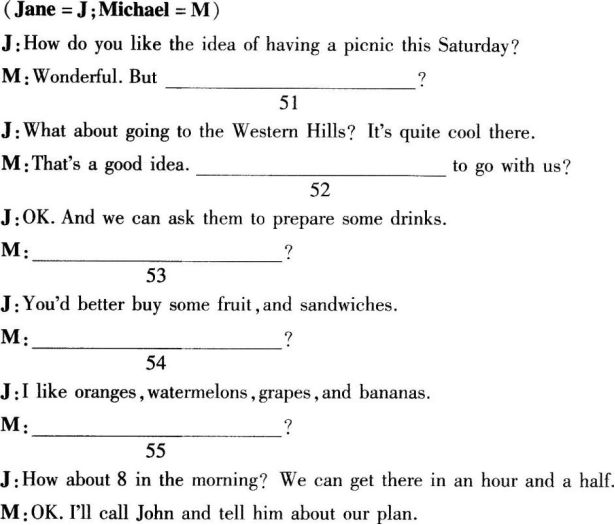2022年成考高起点每日一练《英语》10月17日
考试总分:10分
考试类型:模拟试题
作答时间:60分钟
已答人数:1690
试卷答案:有
试卷介绍: 2022年成考高起点每日一练《英语》10月17日专为备考2022年英语考生准备,帮助考生通过每日坚持练习,逐步提升考试成绩。
试卷预览
-
Brighton is a popular seaside town on the south coast of England.Not long ago, some policemen were very (21).There had been several serious accidents (22) by motorists driving too fast.The police started to set up a speed trap(速度监视器).They measured (23) of 88 yards on a straight road and watched to see (24) a car took to (25) that far.They knew that if a car took six seconds, it was traveling faster (26) the (27) limit of 30 miles an hour.
When the policemen were ready,they hid (28) a hedge(树篱) and started to time passing cars.During their first half an hour, they caught five drivers.The policemen wrote down the (29) of each car and the name and address of the driver.But for the next half an hour the policemen didn' t see anybody (30) too fast.They thought that this was very (31).One of them drove a quarter of a mile along the road and saw two students (32) on the grass.They were holding up a sheet of cupboard so that motorists could see it.On the notice one of the students (33) :"Danger.Speed trap."
The policemen took the notice away and wrote down the names of the students.Later on they were each fined £5 for (34) to stop the police catching motorists who were (35) the law.
1. 第(33)题选择()。Awas writing
Bwrites
Chas written
Dhad written
-
2. You’re the only one()advice he might be listen to.
Awhose
Bwhich
Cwhom
Dwho
-
In January 2004, a 20-year-old woman ran a red light while talking on a cell phone. Her carknocked into another car crossing with the green light directly in front of her. The police found thedriver never touched her brakes ( 刹车) and was traveling 48 mph when she hit the other car. The po-lice were told that the driver was not looking down, pressing buttons. She was looking straight out ofthe windshield(挡风玻璃) talking on her cell phone as she passed four cars and a school bus.
Vision is the most important sense for safe driving. Yet, drivers using cell phones are likely to"look at" but not "see" objects. It is said that drivers using cell phones look but fail to see up to 50percent of the infornmtion while driving. Drivers are looking out of the windshield, but they do notreally deal with the situation on the road.
Although the public appear to be turning against cell phone use while driving, many admit theyregularly talk or text while driving. The police say that nine percent of the drivers at any given timeare using cell phones, and about one in four car accidents are directly related to cell phone use.
Using cell phones while driving has become a serious public health threat (威胁). A few stateshave passed laws making it unlawful to use a handheld cell phone while driving, but these laws give the false message that using a hand-free phone is safe.
3. The word "vision" ( Paragraph 2 ) refers to the sense ofAtaste
Btouch
Chearing
DSight
-
1. 提示:原本擅长化学的Cathy考试时因粗心漏做一页试题。她正闷闷不乐时遇见了Mary。
( Mary = M ; Cathy = C )
M : Hi, Cathy, you don' t look happy. 51 ?
C : I didn' t do well in the chemistry test.
M : Really? I could hardly believe it. Everyone knows you are 52 .
C : But this time 53 .
M : What happened?
C : I missed 54 .
M : What a pity ! So 55 next time !
C : Yes, I will.
-
提示:Bill到商店买L号的黄衬衫,得知该颜色衬衫已售完,想看看蓝的。售货员说蓝色今年很流行,他试穿后决定买下。
(Bill = B ; Shopping Assistant = A )
A:Can I help you, sir?
B: Yes. I ’ m looking for a yellow shirt.
A:____________51____________?
B: Size L.
A: Sorry. The yellow ones of your size____________52____________.
B: It’ s a pity. Do you have that size in blue then?
A: Yes. Blue is____________53____________this year.
B; Well.____________54____________?
A : Sure. Look! It fits you well.
B: Yes, it does____________55____________?
A: 150 yuan.
B: OK. I’ll take it.
2. 根据中文提示,把54空缺少的内容写在线上。
-
Lucy要去艺术展览中心 ,向一位男士问路,该男士告诉她如何前往。 (L=Lucy;S=Sir) L: Excuse me ,sir. 51__________________ the Art Exhibition Centre? S:Yes but it is quite far.It'S about an hour'Swalk.You can take a bus there. L: 52__________________ ? S:You can take Bus No. 15. L: 53__________________ ? S:About 20 minutes. And you can also take a taxi. L:Taxi? That'S a good idea. Thank you very much. S: 54__________________ . L:Goodbye. S; 55__________________.
3. 根据中文提示,把53空缺少的内容写在线上。
-
根据中文提示,把对话中缺少的内容写在线上。这些句子必须符合英语表达习惯。打句号的地方,用陈述句;打问号的地方,用疑问句。
提示:Wilson太太的丈夫生病了,发烧,头疼得厉害。她打电话给格林医生,请他到家里来一趟。格林医生简单询问情况后,答应马上就到。
Mrs.Wilson:Hello, this is Alice.Is Dr.Green there?
Dr.Green : Yes, (51).
Mrs.Wilson:Dr.Green, sorry to call you up at this time of the day.But my husband is very sick.I am rather worried.(52) ?
Dr.Green:Yes, certainly.(53) ?It will help me to decide what to prepare before I come.
Mrs.Wilson : Well, I can' t tell exactly, but (54).
Dr.Green : All right then.Don' t worry.Keep him in bed.(55).
Mrs.Wilson : I' ll do that, Dr.Green.See you soon.
Dr.Green : See you.
1. 第(54)填()。
-
提示:马明是个摄影爱好者。他在飞机场遇到一个可爱的美国小男孩Tom,想给他拍几张照片。
(M=Ma Ming;T=Tom)
M:Hello.I’m Ma Ming. (51) ?
T:My name is Tom.
M:(52) .Tom.?
T:I’m 5 years old.
M:(53) ?
T:I’m from America.
M:Well,welcome to China.
T:(54) .
M:Tom,can I take some pictures of you?
T:Ask my mom,please.
M:(55) ?
T:She’S there in the shop.
2. 第 (51)题答案为().
-
根据中文提示,将对话中缺少的内容写在线上。这些句子必须符合英语表达习惯。打句号的地方,用陈述句;打问号的地方,用疑问句。
提示:Jane和Michael商量周末去野餐。他们讨论要去什么地方,带些什么。Michael建议邀请John和他的女朋友参加。最后他们决定星期六早上8点出发。
3. 第(53)空填()。
-
1. 假设你是小明,光明中学的学生,你给你的好友小华写信讲述你的美国之行。内容包括:先去了纽约,看到许多摩天大楼,但看不到世贸大厦了;两天后去了洛杉矶(Los Angeles),参观了好莱坞,游览了迪斯尼乐园;还去了内华达(Nevada)的里诺(Reno),游览了风景优美的大沪(Dahu)湖。
注意:
1.不要逐字翻译,叙述要连贯。
2.词数应为100左右。
相关试卷
-
2023年成考高起点每日一练《英语》8月31日1293人做过
-
2023年成考高起点每日一练《英语》9月1日640人做过
-
2023年成考高起点每日一练《英语》9月2日1889人做过
-
2023年成考高起点每日一练《英语》9月3日1843人做过
-
2023年成考高起点每日一练《英语》9月4日908人做过
-
2023年成考高起点每日一练《英语》9月5日1968人做过
-
2023年成考高起点每日一练《英语》9月6日475人做过
-
2023年成考高起点每日一练《英语》9月7日1351人做过
-
2023年成考高起点每日一练《英语》9月8日1666人做过
-
2023年成考高起点每日一练《英语》9月9日820人做过
相关题库